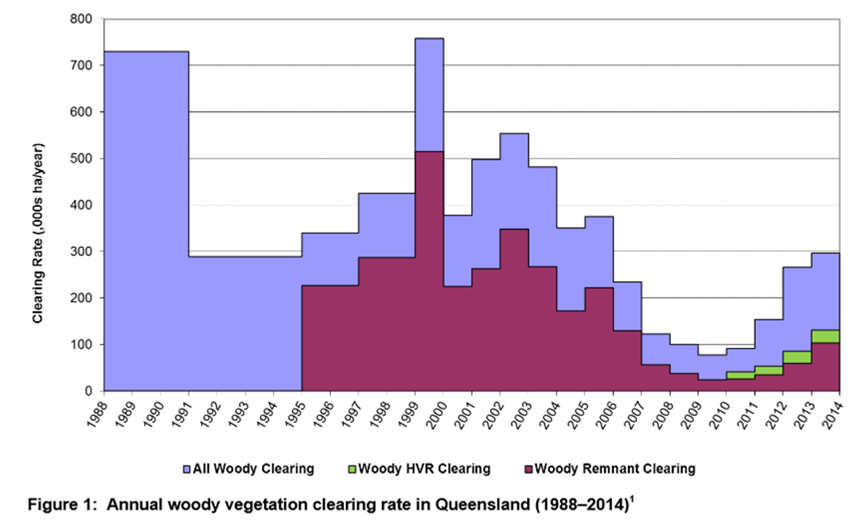The Statewide Landcover and Trees Study (SLATS) was released on Saturday 28 November 2015. This study, prepared by the state Department of Science, Information Technology and Innovation, monitors Queensland’s forests and woodlands to determine the extent of clearing. This most recent study identified that the rate of vegetation clearing in Queensland doubled between 2012 and 2014, most likely as a result of changes in vegetation clearing laws introduced by the Newman Government in 2011. Statewide, the area of clearing increased by a staggering 73% between 2011-12 and 2012-13. This rate continued to climb between 2013 and 2014 and reached nearly 300,000 ha of vegetation per year. Remnant vegetation makes up a significant proportion of all vegetation cleared at 35% in 2013-14 and 22% the preceding year. High value regrowth is now also impacted by relaxed clearing laws and constitutes approximately 10% of the total area cleared.
The study presents a breakdown of clearing by area, vegetation types and by the replacement use of the land. At least 90% of cleared areas over the last two years were replaced with pasture, which is consistent with previous years. Crops, forestry, mining, natural disasters, infrastructure and urban settlement accounted for less than 8% of all clearing in the last year. What has changed of course is the total area of land being cleared annually for pasture – increasing from 134,447 ha in 2011-12 to 241,487 ha in 2012-13 and 273,295 ha in 2013-14.
A copy of the latest SLATS report is available here:
https://www.qld.gov.au/environment/assets/documents/land/slats-2012-14.pdf
As a result of these figures, the Palaszczuk government has identified that it will introduce reforms early next year to reduce tree clearing rates.
If the Palaszczuk government were to overturn tree clearing laws introduced by the Newman government, then the changes to Vegetation Management Act 1999 and policies would be expected to include:
- removal of self-assessable clearing codes, including clearing for encroachment, extractive industry, thinning, agriculture and property infrastructure
- removal of the statewide ‘lock it in’ PMAV (Category B area), therefore allowing changes in remnant status and protection of regrowth vegetation
- re-introduction of protection of high value regrowth over areas not covered by a landholder placed PMAV
- removal of broad scale clearing for agricultural purposes
- removal of exemptions allowing broadscale clearing vegetation by local governments
- changes in the state offset framework, including allowing remnant vegetation to be used as a vegetation offset.
Figure 1 below identifying annual clearing rates is an extract from the Land cover change in Queensland 2012-13 and 2013-2014, Statewide Landcover and Trees Study.
Contact: Geoffrey Sinclair : 07 4994 1000

